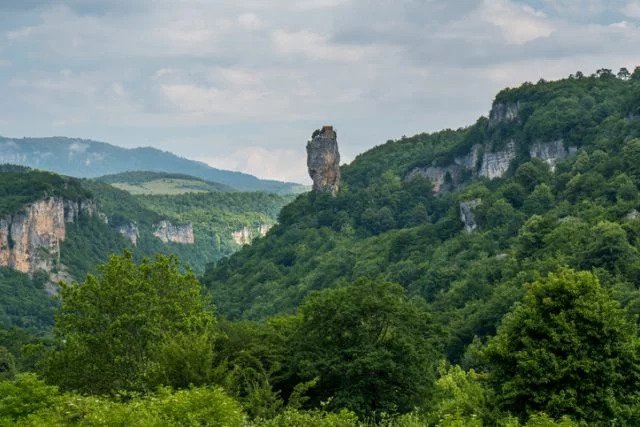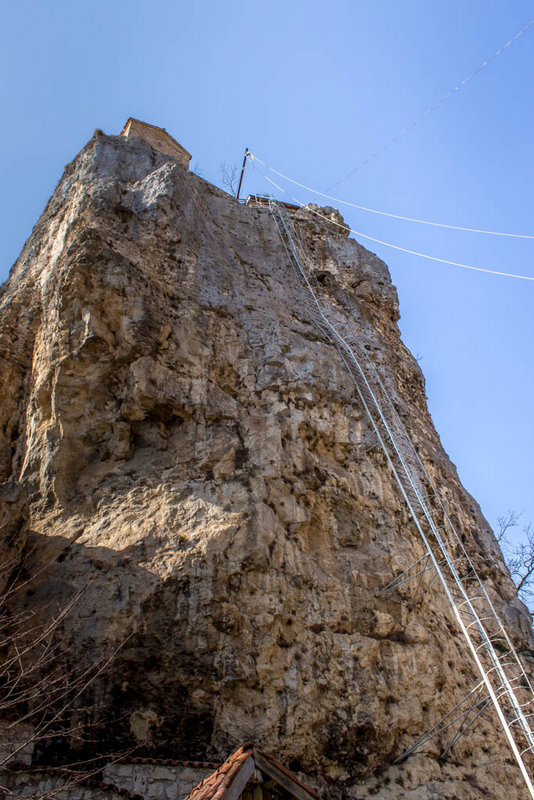The Katskhi Pillar – the Most Incredible Cliff Church in the World
It is not unusual to listen to tales of people who have lived a solemn life away from the world, whenever these stories are reported, people are fascinated and awestruck.
This idea is far from our normal life to most of us. This was the case when the news broke out of a monk alone living on a giant rock in Georgia.
Katskhi, the small town of the Katshkipillar – an enormous natural limestone column that rises 130 feet into the air – is located in the west-georgian area of Imereti.
Perched on the top is a church and three hermit cells, accessible only by climbing a precarious steel ladder. The rock was used by Stylites from at least the 9th century up until the Ottoman invasion in the 15th century.
The Stylites are a group of Christian ascetics who chose to follow the example of Saint Simeon Stylites the Elder, spending their days living in solitude on top of pillars in order to become spiritually closer to God.
In 1993, the Stylite tradition at Katskhi was revived by a monk named Maxime Qavtaradze.

After being abandoned and shrouded in the legend for 500 years, the rock was scaled in 1944 by a Georgian mountaineer named Alexander Japaridze.
Upon reaching the top, Japaridze found the dilapidated remains of an old church as well as the centuries-old bones of the last Christian ascetic who resided there, reports the Daily Mail.
Climbers also came across a slew of other structures, including a wine cellar, a curtain wall, a stone crypt, and three hermit cells. The church was built to honor Maximus the Confessor, a famous Christian monk and theologian.
St. Maximus the Confessor’s church is located in the southeast sector of the pillar. The structure is fairly small, measuring just 12 x 15 feet.
When excavations were carried out, the group also uncovered eight large containers known as kvevris which are used to hold traditional Georgian wine.

In a subsequent ascent up the rock in 2006, the presence of the kvevris along with the construction of a wine cellar provided researchers with enough evidence to conclude that extreme asceticism was a common practice for those who resided there long ago.
This would make it the third time in recent history that the rock has been examined by experts hoping to uncover more about its history.
At present, the rock is inhabited by Maxime Qavtaradze, a middle-aged monk who made the abandoned spiritual dwelling his home in 1993.
In a rare interview in 2013, Qavtaradze told photographer Amos Chapple that making the decision to live at Katshki Pillar was borne from a much-needed change in his personal life.
He explained that after being released from jail on drug-related charges, he felt that the best way to connect with God and purge himself of evil was to meditate upon the Kayshki Pillar, reports CNN.

“It is up here in the silence that you can feel God’s presence,” he claims. For him, living in isolation is the right way to establish a genuine, uninterrupted connection with God.
That said, he does come down the mountain periodically to pray together with men who live in the monastery at the bottom of the pillar — a climb that takes him around 20 minutes, according to the Daily Mail.

His efforts are supported by the men in the monastery, who send him food and other supplies via a winch.
Maxime has no regrets about deciding to live his life in borderline isolation. Although climbing a 130-foot ladder does pose its challenges to Maxime’s middle-aged frame, he told Chapple that he’ll continue to make the journey until his body gives up.





